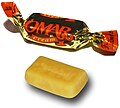Caramel
Caramel is a confectionery product made by heating a variety of sugars. It can be used as a flavoring in puddings and desserts, as a filling in bonbons, or as a topping for ice cream and custard. The process of caramelization consists of heating sugar slowly to around 170°C (340°F). As the sugar heats, the molecules break down and re-form into compounds with a characteristic color and flavor.
A variety of sugars can be used to produce caramel. Sucrose is the most common sugar used, but glucose and fructose are also options, each contributing to variations in flavor, color, and texture. The type of sugar, along with the extent of heating, determines whether the final product will be a soft, chewy caramel or a hard, brittle caramel.
Production[edit]
The production of caramel involves several steps. First, the sugar is dissolved in water and heated. As the solution evaporates, the sugar concentration increases, and the temperature rises. Next, the sugar undergoes thermal decomposition, releasing water and reacting to form new compounds that give caramel its characteristic flavors and brown color. This process is known as the Maillard reaction, a chemical reaction between amino acids and reducing sugars that gives browned foods their desirable flavor.
Types of Caramel[edit]
Caramel can be classified based on its consistency and use:
- Soft Caramel: Used in confectionery to fill chocolates or as a soft chewy treat.
- Hard Caramel: Used for making candies that are meant to be sucked or chewed slowly.
- Liquid Caramel: Used as a flavoring or topping for desserts and ice cream.
- Caramel Coloring: Used in the food and beverage industry to color products such as cola, beer, and sauces.
Health Considerations[edit]
While caramel is enjoyed worldwide, it is high in sugar and should be consumed in moderation. Excessive consumption of sugary treats can lead to dental problems, obesity, and other health issues. Some commercial caramel products may contain additives or preservatives that could cause allergic reactions in sensitive individuals.
Cultural Significance[edit]
Caramel has a significant cultural presence in many countries. In France, for example, salted caramel is a popular flavor for sweets and desserts. In the United States, caramel apples are a traditional treat enjoyed particularly during the fall season.
See Also[edit]
-
Caramel
-
Caramel
-
Caramel
Ad. Transform your life with W8MD's Budget GLP-1 injections from $75


W8MD offers a medical weight loss program to lose weight in Philadelphia. Our physician-supervised medical weight loss provides:
- Weight loss injections in NYC (generic and brand names):
- Zepbound / Mounjaro, Wegovy / Ozempic, Saxenda
- Most insurances accepted or discounted self-pay rates. We will obtain insurance prior authorizations if needed.
- Generic GLP1 weight loss injections from $75 for the starting dose.
- Also offer prescription weight loss medications including Phentermine, Qsymia, Diethylpropion, Contrave etc.
NYC weight loss doctor appointmentsNYC weight loss doctor appointments
Start your NYC weight loss journey today at our NYC medical weight loss and Philadelphia medical weight loss clinics.
- Call 718-946-5500 to lose weight in NYC or for medical weight loss in Philadelphia 215-676-2334.
- Tags:NYC medical weight loss, Philadelphia lose weight Zepbound NYC, Budget GLP1 weight loss injections, Wegovy Philadelphia, Wegovy NYC, Philadelphia medical weight loss, Brookly weight loss and Wegovy NYC
|
WikiMD's Wellness Encyclopedia |
| Let Food Be Thy Medicine Medicine Thy Food - Hippocrates |
Medical Disclaimer: WikiMD is not a substitute for professional medical advice. The information on WikiMD is provided as an information resource only, may be incorrect, outdated or misleading, and is not to be used or relied on for any diagnostic or treatment purposes. Please consult your health care provider before making any healthcare decisions or for guidance about a specific medical condition. WikiMD expressly disclaims responsibility, and shall have no liability, for any damages, loss, injury, or liability whatsoever suffered as a result of your reliance on the information contained in this site. By visiting this site you agree to the foregoing terms and conditions, which may from time to time be changed or supplemented by WikiMD. If you do not agree to the foregoing terms and conditions, you should not enter or use this site. See full disclaimer.
Credits:Most images are courtesy of Wikimedia commons, and templates, categories Wikipedia, licensed under CC BY SA or similar.
Translate this page: - East Asian
中文,
日本,
한국어,
South Asian
हिन्दी,
தமிழ்,
తెలుగు,
Urdu,
ಕನ್ನಡ,
Southeast Asian
Indonesian,
Vietnamese,
Thai,
မြန်မာဘာသာ,
বাংলা
European
español,
Deutsch,
français,
Greek,
português do Brasil,
polski,
română,
русский,
Nederlands,
norsk,
svenska,
suomi,
Italian
Middle Eastern & African
عربى,
Turkish,
Persian,
Hebrew,
Afrikaans,
isiZulu,
Kiswahili,
Other
Bulgarian,
Hungarian,
Czech,
Swedish,
മലയാളം,
मराठी,
ਪੰਜਾਬੀ,
ગુજરાતી,
Portuguese,
Ukrainian



